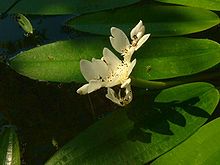Aponogetonaceae
It has been suggested that this article be merged with Aponogetonaceae. (Discuss) Proposed since April 2010. |
| Aponogetonaceae | |
|---|---|

| |
| Aponogeton distachyos | |
| Scientific classification | |
| Kingdom: | |
| (unranked): | |
| (unranked): | |
| Order: | |
| Family: | |
| Genus: | Aponogeton |
| Species | |
|
See text | |
Aponogeton is a genus of 45 - 50 species of flowering plants, the only genus of the family Aponogetonaceae. The Aponogetonaceae is considered to be allied to the Potamogetonaceae - Najadaceae complex of families.
The name was published in Supplementum Plantarum 32: 214 (1782). The name is derived from a geographic location. Some species are used as ornamental plants in aquaria.
Distribution
They are aquatic plants, which are found in tropical to warm temperate regions of Africa, Asia and Australasia.[1]
Aponogeton distachyos is originally from South Africa but has become naturalised in South Australia, Western South America, and Western Europe.
Individual plants are not always easy to identify due to hybridization (particularly those sold as A. crispus - which are often cultivated hybrids with A. natans).
Generally an Aponogeton from Asia will have a single bloom, while those from African heritage (including Madagascar) will have multiple blooms on the same flower stalk.
Ecology
Many species grow in temporarily still or flowing waters and live through the dry period as a dormant tuber. They are fully aquatic herbaceous plants with milky sap, becoming dormant during drought conditions. Most species grow from tubers. Most Asian species remain submerged all year round, whilst the starchy tubercles of the African species are able to survive the dry season by shedding their leaves and undergoing a dormant period.
Economic uses
The tubers of several; species are eaten by humans and their livestock. Some are grown as ornamental plants in aquaria or ponds.
Selected species
- Aponogeton abyssinicus Hochst. ex A. Rich.
- Aponogeton afroviolaceus Lye
- Aponogeton angustifolius Ait.
- Aponogeton azureus H. Bruggen
- Aponogeton bernerianus (Decne.) Hook.
- Aponogeton boivinianus Baill. ex Jum.
- Aponogeton bogneri H. Bruggen
- Aponogeton crispus Thunb.
- Aponogeton desertorum Zeyh. ex A. Spreng.
- Aponogeton distachyos L.f.
- Aponogeton elongatus F. Muell. ex Benth.
- Aponogeton fotianus J. Raynal
- Aponogeton junceus Lehm.
- Aponogeton longiplumulosus H. Bruggen (1968)
- Aponogeton madagascariensis (Mirb.) H. Bruggen
- Aponogeton natalensis Oliv.
- Aponogeton natans (L.) Engl. & K. Krause
- Aponogeton nudiflorus Peter.
- Aponogeton ranunculiflorus Jacot Guill. & Marais
- Aponogeton rehmannii Oliv.
- Aponogeton rigidifolius H. Bruggen
- Aponogeton stuhlmannii Engl.
- Aponogeton subconjugatus Schumach. & Thonn.
- Aponogeton troupinii J. Raynal
- Aponogeton ulvaceus Bak.
- Aponogeton undulatus Roxb.
- Aponogeton vallisnerioides Baker

Cultivation
All Aponogetons are easy to grow when their preferences are met. The Madagascar lace plants (A. madagascarensis) require special handling as they like it cool - 70F max. As of 2010, the Australian species exist in very small numbers in the hobby.
Rest periods
The African species in particular (with the exception of A. rigidifolius that has a rhizome and not a tuber) experience a natural rest period, corresponding to their habitat drying out in the wild. The Asian species may also have a rest period, but this is temperature related. As the plant stops growing it can be taken out of the pond or aquarium and put in a bowl of damp sand. Keep the bowl in a dark, cool place with the sand kept damp for approximately 2 – 3 months at a temperature of about 50 - 64F (10 - 18C) until small leaves are seen to sprout from the tuber when they can be returned to the pond or aquarium.[5]
References
- ^ Watson, L. & Dallwitz, M. J. (1992 onwards): Aponogetonaceae
- ^ African Flowering Plants Database: Aponogeton
- ^ Huxley, A., ed. (1992). New RHS Dictionary of Gardening. Macmillan ISBN 0-333-47494-5.
- ^ van Bruggen, H. W. E. (1985). "Monograph of the genus Aponogeton (Aponogetonaceae)". Bibliotheca botanica. 33 (137). Stuttgart: E. Schweizerbart'sche Verlagsbuchhandlung: i–viii, 1–76. ISBN 978-3-510-48008-1. ISSN 0067-7892. Retrieved 2010-03-13.
{{cite journal}}: Cite has empty unknown parameters:|trans_title=and|month=(help) - ^ Gesting, B. Nature and Aquarium



